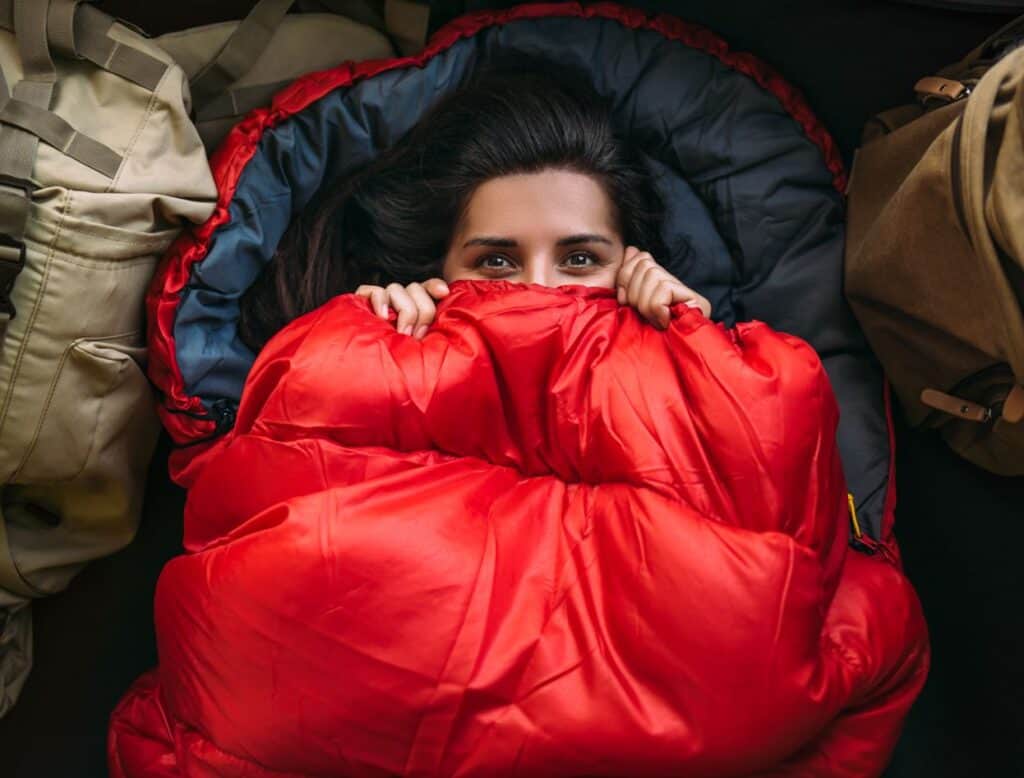Are you planning your next outdoor adventure and looking for the perfect sleeping bag to keep you warm and cozy throughout the night? Look no further! In this ultimate guide, we will help you find the coziest sleeping bag that suits your needs.
Whether you’re backpacking through the mountains, camping by the lake, or embarking on a road trip, a high-quality sleeping bag is essential for a good night’s sleep. We understand that choosing the right sleeping bag can be overwhelming, with so many options available on the market. That’s why we’ve done the research for you, so you can make an informed decision.
In this comprehensive guide, we will walk you through everything you need to know about sleeping bags, including the different types, insulation options, temperature ratings, and important features to consider. We’ll also provide expert tips on how to care for your sleeping bag to ensure its longevity.
So get ready to embark on your next adventure with the ultimate comfort and warmth of a cozy sleeping bag. Let’s dive in and find the perfect companion for your outdoor escapades!
Importance of a good sleeping bag for outdoor adventures
A good sleeping bag is crucial for any outdoor adventure. It not only provides warmth and comfort but also ensures a good night’s sleep, allowing you to wake up refreshed and ready to take on the day’s activities. When you’re out in the wild, away from the comfort of your bed, a cozy sleeping bag becomes your sanctuary.
One of the main reasons why a high-quality sleeping bag is important is its ability to keep you warm. Outdoor temperatures can drop significantly, especially during the night, and a good sleeping bag with proper insulation will help retain your body heat, preventing you from getting cold. This is particularly important in cold climates or during winter camping trips.
Another important factor to consider is comfort. A well-designed sleeping bag will provide ample room for you to move around and find a comfortable sleeping position. It should also have a soft and cozy interior lining, ensuring a pleasant sleeping experience. Additionally, a good sleeping bag will have features like a hood or a draft collar to prevent heat from escaping and cold air from entering.
Lastly, a high-quality sleeping bag is often made from durable materials that can withstand the rigors of outdoor adventures. It should be able to withstand rough handling, moisture, and dirt without compromising its performance. Investing in a good sleeping bag will not only provide immediate comfort but also ensure its longevity for future trips.
Different types of sleeping bags
When it comes to sleeping bags, there is a wide variety of options available to suit different needs and preferences. Understanding the different types will help you choose the right sleeping bag for your adventures. Let’s take a look at the most common types of sleeping bags:

- Mummy Sleeping Bags: Mummy sleeping bags are designed to provide maximum warmth and weight efficiency. They are narrower at the feet and taper towards the head, resembling the shape of a mummy. This design minimizes the amount of air space inside the bag, reducing heat loss. Mummy sleeping bags are great for cold weather camping or backpacking trips where warmth is a top priority.
- Rectangular Sleeping Bags: Rectangular sleeping bags offer more room to move around and are a popular choice for car camping or family camping trips. They have a rectangular shape that offers more space for your legs and arms, allowing for a more comfortable and relaxed sleeping position. However, rectangular sleeping bags tend to be bulkier and heavier compared to mummy bags.
- Semi-Rectangular Sleeping Bags: Semi-rectangular sleeping bags combine the features of mummy and rectangular bags. They offer a compromise between warmth and comfort, providing a good balance for most camping scenarios. Semi-rectangular bags have a slightly tapered shape, providing more warmth than a rectangular bag while still offering some room for movement.
- Double Sleeping Bags: If you’re camping with a partner or prefer extra space, double sleeping bags are a great option. These bags are designed to accommodate two people comfortably, with a larger size and wider shape. Double sleeping bags are perfect for couples or individuals who enjoy having extra room to stretch out.
- Sleeping Bag Systems: Sleeping bag systems consist of a combination of sleeping bags and liners that can be used together or separately, depending on the weather conditions. These systems offer versatility and allow you to adjust the insulation level according to the temperature. They are particularly useful for backpackers or adventurers who face varying weather conditions.
Now that you’re familiar with the different types of sleeping bags, you can choose the one that best suits your needs and preferences. Remember to consider the climate, your sleeping habits, and the type of adventure you’ll be embarking on.
Factors to Consider When Choosing a Sleeping Bag
When it comes to choosing a sleeping bag, there are several factors you need to consider to ensure you find the coziest option for your needs.
- Temperature Ratings: One of the most important factors to consider is the temperature rating of the sleeping bag. This rating indicates the lowest temperature at which the bag will keep you warm. It’s crucial to choose a bag with a temperature rating suitable for the climate and conditions you’ll be camping in. If you plan to camp in colder temperatures, look for a bag with a lower temperature rating to ensure you stay warm throughout the night.
- Insulation Types: Sleeping bags come with different insulation types, each offering its own advantages. The two most common insulation types are down and synthetic. Down insulation is lightweight, highly compressible, and provides excellent warmth. Synthetic insulation, on the other hand, is more affordable, retains warmth even when wet, and dries quickly. Consider your budget, the expected weather conditions, and any allergies or ethical concerns when choosing between the two.
- Sleeping Bag Shape and Size: Sleeping bags come in various shapes and sizes, including mummy, rectangular, and semi-rectangular. Mummy-shaped bags are more form-fitting and offer better heat retention, while rectangular bags provide more room to move around. The size of the sleeping bag is also important, as you’ll want to ensure you have enough space to sleep comfortably. Consider your sleeping style and personal preferences when deciding on the shape and size of your sleeping bag.
- Weight and Packability: If you plan to backpack or hike with your sleeping bag, weight and packability become important factors to consider. Lightweight and compressible sleeping bags are ideal for those who need to save space and reduce weight in their backpack. However, if you prioritize comfort over weight, a heavier and bulkier sleeping bag may be more suitable for car camping or short hikes.
- Additional Features: Pay attention to the additional features offered by different sleeping bags. Some bags come with draft collars and draft tubes to prevent cold air from seeping in, while others have built-in hoods or pillow pockets for added comfort. Consider any specific features you may need, such as zippered vents for temperature control or a two-way zipper for easy access.
With these factors in mind, you can narrow down your options and find a sleeping bag that meets your specific needs and preferences.

Temperature Ratings and Insulation Types
Temperature ratings and insulation types are crucial considerations when choosing a sleeping bag. Let’s take a closer look at each of these factors.
Temperature Ratings: Sleeping bags are typically assigned temperature ratings to help you determine their suitability for different weather conditions. These ratings are categorized into three main types: comfort, lower limit, and extreme.
- Comfort Rating: The comfort rating indicates the lowest temperature at which the average person can sleep comfortably in the bag. If you’re a cold sleeper or planning to camp in colder temperatures, it’s advisable to choose a bag with a comfort rating lower than the expected nighttime temperature.
- Lower Limit Rating: The lower limit rating indicates the lowest temperature at which a cold sleeper can sleep without excessive cold-related symptoms. If you’re a warm sleeper or camping in moderate temperatures, a bag with a lower limit rating close to the expected nighttime temperature should suffice.
- Extreme Rating: The extreme rating indicates the lowest temperature at which a woman can sleep for six hours without risk of hypothermia. However, it’s important to note that the extreme rating is not intended for regular use, as it may lead to discomfort and potential health risks.
While temperature ratings provide a general guideline, it’s essential to consider other factors such as personal preferences, clothing layers, and sleeping pad insulation to ensure maximum comfort and warmth.
Insulation Types: Sleeping bags are insulated with either down or synthetic materials, each with its own pros and cons.
- Down Insulation: Down is a natural insulator derived from the soft feathers of ducks or geese. It provides excellent warmth-to-weight ratio, is highly compressible, and offers superior insulation. Down sleeping bags are known for their durability and long lifespan. However, down insulation loses its insulating properties when wet and takes longer to dry compared to synthetic insulation. Additionally, down sleeping bags tend to be more expensive than their synthetic counterparts.
- Synthetic Insulation: Synthetic insulation is made of polyester fibers that mimic the insulating properties of down. Synthetic sleeping bags are more affordable, retain warmth even when wet, and dry quickly. They are a suitable choice for damp or humid conditions where moisture resistance is important. While synthetic sleeping bags don’t provide the same warmth-to-weight ratio as down, they are a practical and cost-effective option for most outdoor enthusiasts.
Consider your budget, expected weather conditions, and personal preferences when choosing between down and synthetic insulation. Both options have their merits, so it ultimately comes down to finding the right balance for your needs.
Sleeping Bag Shapes and Sizes
Sleeping bag shapes and sizes play a crucial role in determining comfort and heat retention. Let’s explore the different shapes and sizes available.
Mummy-shaped Bags: Mummy-shaped bags are designed to closely contour your body, maximizing heat retention and minimizing dead space. These bags are narrower at the feet and wider at the shoulders, resembling the shape of a sarcophagus. Mummy-shaped bags are ideal for cold weather camping, as they provide excellent insulation and prevent cold air from entering. However, some people may find the snug fit restrictive or uncomfortable, especially if they prefer more freedom to move around while sleeping.
Rectangular-shaped Bags: Rectangular-shaped bags offer more room to move around and provide a less restrictive sleeping experience. These bags are wider throughout and have a boxy shape. Rectangular bags are ideal for those who prefer more space or tend to move around a lot while sleeping. They are also a popular choice for car camping or sleepovers, where weight and packability are less of a concern. However, rectangular bags may not retain heat as efficiently as mummy-shaped bags, so they may not be suitable for very cold temperatures.
Semi-rectangular Bags: Semi-rectangular bags offer a middle ground between mummy-shaped and rectangular-shaped bags. They provide a balance of roominess and heat retention, making them versatile options for various camping conditions. Semi-rectangular bags are wider at the shoulders and hips, allowing for more movement without compromising insulation. If you’re unsure about which shape to choose, a semi-rectangular bag can be a good compromise.
Consider your sleeping style, body shape, and personal preferences when deciding on the shape and size of your sleeping bag. Keep in mind that a snug fit is essential for heat retention, so choose a size that allows for layering and movement without excessive empty space.
Popular Sleeping Bag Brands and Models
With so many brands and models available on the market, it can be overwhelming to choose the right sleeping bag. Here are some popular brands and models known for their quality and performance:
- The North Face: The North Face offers a wide range of sleeping bags designed for various climates and activities. Their bags are known for their durability, insulation, and innovative features. The North Face caters to different budgets and preferences, making them a reliable choice for outdoor enthusiasts.
- Marmot: Marmot is renowned for their high-quality sleeping bags that combine comfort, warmth, and durability. Their bags are designed with attention to detail, using premium materials and insulation. Marmot offers a range of options suitable for different temperatures and activities, ensuring there’s a bag for every adventure.
- REI: REI is a trusted brand that offers a diverse selection of sleeping bags to suit different needs and budgets. Their bags are known for their performance, quality, and value for money. REI also has an excellent return policy and customer service, making them a popular choice among outdoor enthusiasts.
- Mountain Hardwear: Mountain Hardwear produces high-performance sleeping bags that are lightweight, durable, and well-insulated. Their bags are designed for extreme conditions, making them a top choice for mountaineers and winter campers. Mountain Hardwear is known for their innovative features and commitment to quality.
- Kelty: Kelty offers a range of affordable sleeping bags that deliver on comfort and performance. Their bags are designed with practical features and are suitable for a variety of outdoor activities. Kelty is a reliable brand for those on a budget or beginners looking for a quality sleeping bag.
These brands are just a few examples of the many reputable options available. Consider your specific needs, preferences, and budget when choosing a brand and model that suits you best. It’s also helpful to read reviews and seek recommendations from fellow outdoor enthusiasts to ensure you make an informed decision.
Tips for Caring and Maintaining Your Sleeping Bag
Caring for your sleeping bag is essential to ensure its longevity and optimal performance. Here are some tips to help you maintain and care for your sleeping bag:
- Follow the manufacturer’s instructions: Read and follow the care instructions provided by the manufacturer. Different sleeping bags may have specific cleaning and maintenance requirements, so it’s important to adhere to these guidelines to avoid damaging the bag.
- Air out your sleeping bag: After each camping trip, make sure to air out your sleeping bag to remove any moisture or odors. Hang it in a well-ventilated area or lay it flat to allow proper airflow. This helps prevent the growth of mold or mildew and keeps your bag fresh for future use.
- Spot clean when necessary: If your sleeping bag gets dirty during your trip, spot clean it as soon as possible. Use a mild detergent and warm water to gently clean the affected areas. Avoid using harsh chemicals or excessive scrubbing, as this can damage the insulation or fabric.
- Avoid overstuffing: When storing your sleeping bag, avoid overstuffing it in a stuff sack or compression sack, as this can compress the insulation and reduce its loft. Instead, use a larger storage sack or hang it in a dry, well-ventilated area to maintain its loft and prevent damage.
- Wash your sleeping bag properly: When it’s time to wash your sleeping bag, follow the manufacturer’s instructions for machine or hand washing. Use a front-loading washing machine or a large commercial machine to ensure the bag has enough room to move freely. Use a gentle cycle and a mild detergent specifically designed for down or synthetic insulation. Rinse the bag thoroughly to remove any soap residue.
- Dry your sleeping bag carefully: After washing, dry your sleeping bag thoroughly to prevent mold or mildew growth. Hang it in a well-ventilated area or use a large commercial dryer on low heat. Add clean tennis balls or dryer balls to help fluff the insulation. Avoid using high heat or direct sunlight, as this can damage the fabric and insulation.
By following these care and maintenance tips, you can extend the lifespan of your sleeping bag and ensure it remains in top condition for many adventures to come.
Conclusion: Find Your Perfect Sleeping Bag for a Cozy Night’s Sleep in the Great Outdoors
Choosing the right sleeping bag is essential for a comfortable and cozy night’s sleep during your outdoor adventures. By considering factors such as temperature ratings, insulation types, sleeping bag shapes and sizes, and additional features, you can find the perfect sleeping bag that meets your specific needs and preferences.
Remember to choose a temperature rating suitable for the climate and conditions you’ll be camping in, and consider whether down or synthetic insulation is the best choice for you. Think about your sleeping style and personal preferences when deciding on the shape and size of your sleeping bag.
Explore popular brands and models known for their quality and performance, and read reviews to ensure you make an informed decision. Finally, take good care of your sleeping bag by following the manufacturer’s instructions and implementing proper cleaning and maintenance practices.
With the right sleeping bag by your side, you can enjoy a cozy night’s sleep in the great outdoors, waking up refreshed and ready to embrace new adventures. Happy camping!
